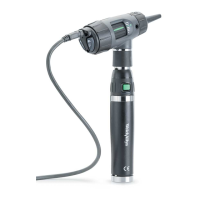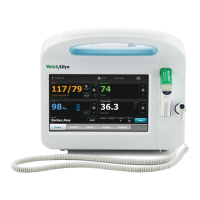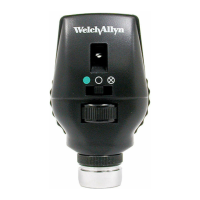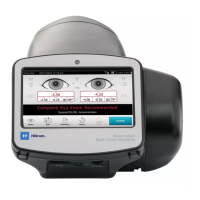Recommended Screening Protocol
The recommended screening protocol is based on a four-part procedure
consisting of case history, visual inspection, pure-tone audiometry, and
tympanometry. These guidelines can be used for all ages, however, they are
designed specifically for children and young adults (through age 40). Referral
criteria are presented in Table 6 on page B-42. These criteria may require
alteration for various clinical settings and populations.
The protocol is presented in flow chart format in Figure 34. The flow chart
is a representation of the logic used to determine the need for referral. It
does not represent the order in which test procedures are administered.
With the exception that visual inspection should precede tympanometry,
the order of test procedures is unimportant. The screening protocols de-
scribed must be supervised by a clinical audiologist. Each test component,
indicated by a numbered box in Figure 34, is described below:
A recent, otologic history of otalgia or otorrhea is sufficient cause for
immediate medical referral.
Visual inspection of the ear may produce sufficient cause for medical
referral without the need for further testing. Referral criteria include:
structural defect of the ear, head, or neck; inflammation, blood, effusion,
excessive cerumen, tumors, or foreign body in the ear canal; or eardrum
appearance consistent with active middle-ear disease. When visual
inspection indicates the need for medical referral, tympanometry is not
necessary. When visual evidence of middle ear infection is present, or
when a pressure-equalization tube is in place, tympanometry should
not be performed unless requested by a physician.
Audiometric screening should be performed by the method described
in the ASHA Guidelines for Identification Audiometry (ASHA, 1985).
Those guidelines recommend screening with pure-tone stimuli presented
at 20 dB HL (re: ANSI S3.6-1989) with frequencies of 1000, 2000, and
4000 Hz. Failure to respond to any frequency constitutes failure of the
audiometric screen. In accordance with the Identification Audiometry
Guidelines, failure of the audiometric screen should be confirmed by
a rescreen, either on-site or by additional testing at a later date. If the
audiometric screen is failed on the second administration, a complete
audiologic evaluation should be performed.
Low static admittance (Peak Y [Ya]) associated with an abnormally-large
volume in front of the probe is evidence of a tympanic membrane per-
foration and warrants immediate referral. The presence of (Vec [Vea])
(estimated at 200 daPa) exceeding the 90% range listed in Table 6 on
page B-42, and in the presence of a flat tympanogram is evidence of a
large volume and should result in a medical referral.
B-41
Appendix B
1
56
34
2

